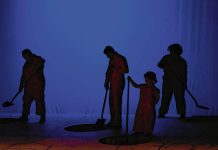olumbus has its share of widely known public art.
Henry Moore’s “Large Arch.”
Jean Tinguely’s “Chaos I.”
Dessa Kirk’s “Eos.”
[sc:text-divider text-divider-title=”Story continues below gallery” ]
You routinely point them out to friends or family who are visiting. After all, they are points of civic pride for Columbus.
Throughout the years, Columbus has been home to many pieces of public art created by artists from around the world, working at the top of their game. The pieces were treasured and loved, or at least valued for their addition to the aesthetics of Columbus.
And then, some of those pieces just disappeared.
“Knowing is the first act of preservation,” said Richard McCoy, leader of the Columbus Design Landmarks effort, a project of Heritage Fund. “Knowing and recognizing. If you don’t know what is there, it’s lost.”
McCoy, along with members of the Columbus Design Landmarks’ advocacy group, are working to bring some of this lost history back into the public eye, starting with Alexander Girard’s maquettes; Rogelio Polesello’s Lucite sculptures, and Costantino Nivola’s herd of horses, formerly at the W.D. Richards Elementary school and now lost to the ages. Maybe.
“There are some challenges with things being lost,” McCoy said. “It seems to me, within the community, there is a growing interest about how to best take care of its design.”
Girard’s maquettes
In 1965, in an attempt to give Washington Street a cohesive look in line with his love of and vision for small-town America, interior designer Alexander Girard produced maquettes of Washington Street. In these two-dimensional maquettes, Columbus’ main drag was given a makeover. Or make-under, depending on how you see it. With his playful but muted colors and low-hung shop signs, Girard was suggesting a healthy glow rather than a full face of makeup.
“My sense is he didn’t like the junkiness or randomness of the signage,” said Tricia Gilson, archivist at the Columbus Indiana Architectural Archives.
It’s not completely clear what entity put Girard on the case, but many downtown business owners adopted the proposed changes, painting their buildings in Girard’s suggested color schemes and swapping out their signs for less obtrusive options.
“In part, it was a way to do historic preservation,” Gilson said. “It was always a way to balance out modern architecture and to have civic pride in Columbus’ history.
The Washington Street revitalization was featured in the December 1965 issue of Architectural Forum. As time wore on, the maquettes fell out of sight and out of mind — or vice versa.
You can still find 10 of the 20 original maquettes at City Hall, in an office just to the right of the main revolving door.
As for the rest, Gilson said, they are at the Vitra Design Museum in Weil am Rhein, Germany. The Architectural Archives has photographs of the complete set, as does Neal Paint and Wallpaper at 523 Washington St.
Polesello’s piece
On Nov. 5, 1970, J. Irwin and Xenia Miller purchased three works of art by Argentinian artist Rogelio Polesello. The pieces consist of large, lucite bubbles, strung in an array almost like a spider web. Two feature colorless lucite bubbles and the third, which visitors to the Miller House can see on display, has colored bubbles, said Ben Wever, site administrator at the Miller House.
The Millers originally acquired the pieces after a trip to South America. The smaller, uncolored lucite sculpture likely wound up in storage at the Cummins Corporate Office Building, Wever said.
Wever, a Columbus native, remembers moving the largest piece, “Concave Circles,” in a 2009 inventory by Christie’s auction house, from its original spot at 432 Washington St. to the Visitors Center, where it was on display until Xenia Miller’s death in 2008.
The piece, part of the Miller estate, was reclaimed by Irwin Management Company, said Sarla Kalsi, its president and CEO.
Kalsi said it had been on loan.
“I just can’t recall where it went and whether it was sold,” she said.
“Once the people involved in caring for these pieces for years are out of the picture, things just slip away and no one knows what happened to them,” Wever said.
Nivo
la’s Horses
A herd of voluptuous horse sculptures circled around an ash tree at W.D. Richards Elementary School.
The shapely equine forms, executed in fiberglass, embodied a playful spirit appropriate to the late 1960s and early ’70s.
McCoy, who has seen one of the horses in person, describes it as standing about three feet high.
Installed in 1970, the horses were created by Italian sculptor Costantino Nivola, a gift of J. Irwin and Xenia Miller, perhaps inspired by a similar herd of horses, also by Nivola, on a playground on the Upper West Side in New York City.
No one is quite sure how it came to be that Nivola was commissioned for the sculptures.
Richard McCoy suggests that Serge Ivan Chermayeff, who made the colorful panels in the hallways at Southside Elementary School, had connections to Nivola — who had sprung from the Bauhaus Movement into the Harvard Graduate School of Design.
“(Nivola) was similar to (Jean) Tinguely,” McCoy said. “He was never very big in the United States.”
Through time, the horses fell into disrepair, their fiberglass not weathering the elements well.
According to a May 18, 1990, article in The Republic, the horses’ disappearance was sudden. “(Dee) Black (a third-grade teacher) said that one day, they were just gone.”
And what happened to the herd?
Bartholomew Consolidated School Corp. Superintendent John Quick can account for one horse: It’s in his office at the school district’s Central Avenue headquarters. He found it in the basement at Richards Elementary School.
His grandchildren call the chubby horse “the Buddha pony.”
Another horse remains at Richards Elementary, along with a photo of the herd, captured in time under the tree under which they were originally installed. The tree, depending on the account, was struck by lightning or is still in place but diseased.
Part of the importance of putting out the stories of Nivola’s horses — and indeed, retelling the story of all of the forgotten art — is the challenge to the community, McCoy said, to think about the pieces and to share the narrative.
“When I think of things that are lost, they’re fading from consciousness,” he said. “When we think about them, then they become not lost,” McCoy said.




